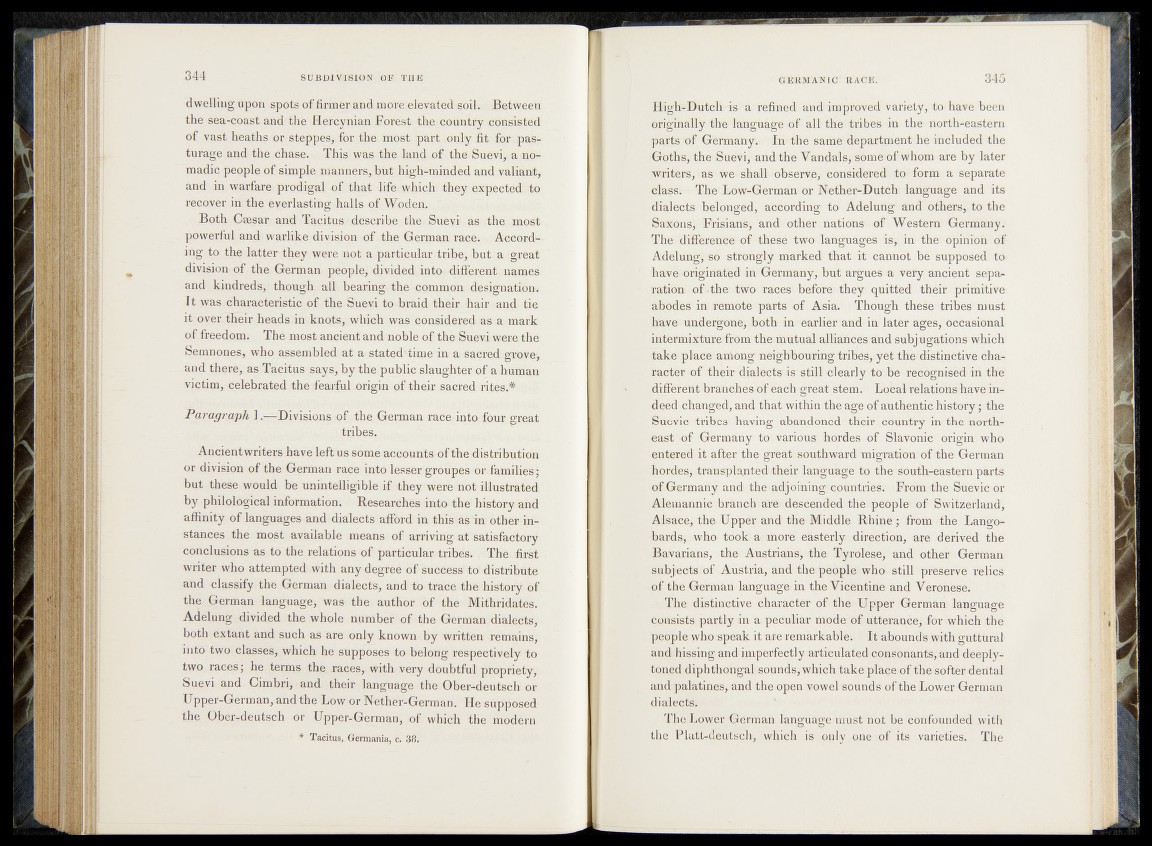
dwelling upon spots of firmer and more;eievated;soil. Between
the sea'-Coast and the Hercynian Forest the country consisted
of vast heaths or steppes, for the. most, part -only fit for pasturage
and the chase. < This was the land of the-Suevi, a nomadic
people o f simple manners, but high-minded and valiant,
and in warfare prodigal of that life which they expected; to
recover in the everlasting halls of Wöd.en. ,r
Both Gæsar and Tacitus.? descri be the Suave as the;, most
- powerful and warlike division of. the German race. . According
to the latter they were not a particular tribe, but a great
division of the German people, divided^ in to-different„ names
and kindreds, though, all bearing-the common designation?.
It was characteristic of the Suevi to braid*their hair and tie
it-over tfieir heads in knots, which was eonsideipdias a mark
of freedom. The most ancient and noble of the Su.ev.k were the
Semnones, who assembled at a stated'time . in a sacred 'Öm -ove5',
and there, as Tacitus says, by the public slaughter of a human
victim, celebrated the fearful origin of their sacred .rites#,!»
Paragraph 1.—Divisions, of the German raee into, four^g.rjsat
tribes. .
Ancient writers have left us some accounts; of the distribution
or division of the German race into lesser groupes or families;
but these would be unintelligible if~they*were not illusirated
by philological information. Researches into the history and
affinity of languages and dialects afford in this as'in other iîtfv
stances the most available means of arriving at satisfactory
conclusions as to the relations of particular tribes. The fitet
writer who attempted with any degree of success* tó distribute
and classify the German dialects, and to trace the history of
the German language, was the author of the Mithridafes.
Adelung divided the whole number of the German dialects,
both extant and such as are only known-by written remains,
into two classes, which he supposes to belong respectively to
two races; he terms the„races, with very doubtful propriety,
Suevi and Cimbri, and their language the Ober-deutsch or
Upper-German, and the Low or Nether-German. He supposed
the Ober-deutsch or Upper-German, of which the modéra
* Tacitus, Germania, c. 38.
High-Dutch is a refined and improved variety, to have been
originally the language of all the tribes in the north-eastern
parts-of Germany.; In the same department he included the
Goths, the Suevi, and the Vandals; some of whom are by later
writers, • as We« shaiWobservp, considered to form a separate
'iJaSSr ’ The LoW-German or Nethér-Dutch language and its
dialects' belonged, according to Adelung- and others, to the
SaxonS^-Frisians; and- other nations': of Western Germany.
The difference? oft;these two languages- is,, in the opinion of
Adelung, so?.strongly marked that it cannot be supposed toll
ave originated im Germany, but? argues a very ancient sepa-
Tatiön of .the two -races» before they*'quitted their primitive
abodes in remote parts oft Asia. Though! these, tribes must
have undergone}-both in earlier and in' later ages, occasional
intermixture from the mutual alliances and subjugations which
take place»abk>ng neighbouring tribes,iyet the1 distinctive cha-
.racter of their dialectsfe'S-till clearly to be Tecognisèd in the
different branehésföfiladh g‘iN£at stem.’ Local relations ba tek te
dedd; changed, and that within the^réjdaf authentic history; the
Suevicteibds 'having1 abandoned their country in the north-
i ^ s t pf Germany tq-various hordes of Slavonic origin who
èntered it after the? great southward migration, of the German
hordes, transplanted their language to ;%heisouth-eastern parts
of Germany and the adjoining? conn triest From the Suevic or
Alemannic branch ïarë.-descencted; the people-of Switzerland,
Afeaée, the Upper "and the Middle Rhine ; from sthe Lango-
bards, who took;a more easterly! direction, a^e derived the
Bavarians, the Austrians, the Tyrolese, and other German
subj ects of Austria;, iind the people who still preserve relics*
of the German language! in the .Vicentine and Veronese.
• Ther distinctive Character o ftth ^U p p e r German language
consists partly in a peculiar modetef m-tt er ance, for which the
pasple whft^etók t e a t e r e ^ It abounds with guttural
and-hissing and imperfectly articulated consonants,:anddeeply-
toned diphthongal sounds, which take place of the softer dental
and palatines, and the open vowel sounds of the Lower German
dialects.
The Lower German language must not be confounded with
the Platt-deutsch, which is only of its * varieties. The